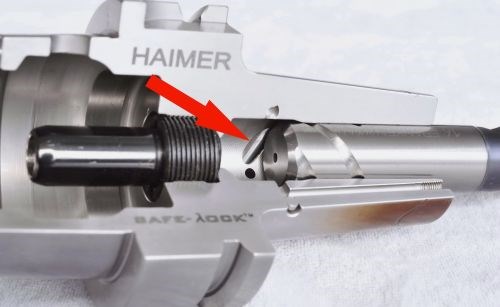Defeating Axial Forces
Prolong tool life and avoid failure—and even workpiece damage—with a toolholding system specially designed to provide pull-out protection.
Share




High performance machining (HPM) involves powerful equipment spinning tools at a terrific rate of speed. Add hard-to-machine materials such as titanium to the mix and you’re courting potential tool failure and damage to the workpiece. The Safe-Lock tool shank holder system for roughing applications from Haimer was designed to prevent such an event by preventing pullout and runout, and also preserving concentricity.
HPM places enormous demands on toolholding, with axial forces sometimes causing a slow “micro-creeping” movement that can pull the tool out of the chuck. Even frictional clamping methods with extremely high clamping forces aren’t always enough to avoid this scenario, the company says.
The Safe-Lock System addresses this problem with special drive keys in the chuck and grooves in the tool shank that prevent the milling cutter from spinning during extreme machining, or from being pulled from the chuck. This video shows the toolholding system in action. Pull-out protection and runout accuracy lead to low vibration and more efficient machining, allowing for increased cutting depths and feeds and therefore higher metal removal rates. Tool wear is also minimized.
Read this article from Modern Machine Shop about HPM of titanium using the Safe-Lock System.


This cutaway of the Safe-Lock shows the drive key at the bottom of the shank of the tool holder, which grips into the groove in the tool shank.
Related Content
-
Ceratizit's Updated Tooling Solutions Improve Machining Performance
The company has upgraded its EcoCut indexable inserts lineup, as well as introduced two new toolholding and workholding solutions.
-
Quick-Change Tool Heads Reduce Setup on Swiss-Type Turning Centers
This new quick-change tooling system enables shops to get more production from their Swiss turning centers through reduced tool setup time and matches the performance of a solid tool.
-
How to Troubleshoot Issues With Tool Life
Diagnosing when a tool is failing is important because it sets an expectation and a benchmark for improvements. Finding out why gives us a clue for how to fix it.



















.png;maxWidth=300;quality=90)

